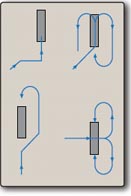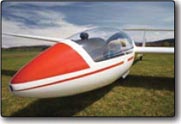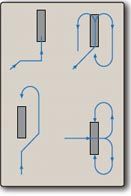In the August 2006 article, “Five Ways to Better NPAs,” the author made an error by confusing straight-in approaches with straight-in landings. In the highlighted box called “Defining the Non-Precision Approach” the writer defined a straight-in approach as “a procedure where the final approach course is aligned to within 15 degrees of the runway heading….” This is incorrect; a straight-in approach is one in which there is no procedure turn. 288 What the writer defined was a straight-in landing, one in which you land on the runway named in the title of the approach and in which the final approach course is aligned within 
It is important to note that a straight-in approach can be followed by either a straight-in landing or a circle-to-land maneuver.
Terence Rafferty
Saint Paul, Minn.
Thanks for the correction!
Sailplanes Again
I dont wish to beat a dead horse, but I would like to add a bit to the discussion about learning to fly in a glider vs. in an airplane.

288
First, while we dont have engines and instruments to contend with in a glider, we do have to learn about and focus constantly on micrometeorology to extract the energy to stay up long enough to learn something. This requires at least as much concentration as dealing with the absent machinery.
Also, we are required to learn formation flying at the end of a 200-foot rope before we can even fly solo.
I have had licensed power pilots as students who just could not make it as a glider pilot because of inattention to, or lack of concern for, precise piloting. It is not difficult, but it is demanding; we cannot just gaze around at the scenery and expect to stay aloft.
The beauty is that no two days are alike because of the weather. Glider pilots and fighter pilots talk about their flights endlessly; do other pilots not do this?
Nyal Williams
Via e-mail
Power Vacuum?
I am puzzled by your assertion in “If I Had A Hammer” (August 2006) that “a lower-powered airplane isnt a good choice for serious cross-country flying.”
There are thousands of low-powered planes based at high elevation airports and pilots fly them daily without incident. My late husband earned his Private at Logan, Utah-elevation 4500-in a Cessna 152 and flew us all over the Rockies in it. I earned my Private in Leesburg, Fla., but Ive flown my 160-hp PA-28-140 all over the U.S., including New Mexico, Colorado, Wyoming, Utah and Idaho.
I believe it is a disservice to flatlanders who own lower-powered airplanes to discourage them from making long trips through high terrain. The accident of that articles focus did not occur because the Skyhawk is inappropriate for mountain flying but because the pilots were ill-prepared for and uninformed about mountain flying procedures.
The keys to success for flatlanders venturing into the Rockies are preparation and common sense. Read books and magazine articles about mountain flying. Take AOPAs online mountain flying course. Seek advice from pilots hanging around high altitude airports. Learn about density altitude, leaning and reduced engine performance.
Whenever possible, follow major highways, which are cut through mountain passes and which connect cities that have airports. Fly around peaks, not over them. Land on paved runways in the valleys. Load well below gross, get weather briefings and file flight plans.
Respect the mountains, but dont fear them. Enjoy your little plane!
Melinda Simmons
Oxford, Fla.
Theres no question that smaller singles can safely be flown in the mountains or through some types of weather when everything is going right and the pilot is well-trained. Of course, weather forecasts can go bust and even benign geography can surprise experienced pilots.
But, in our view, the real problem is when a less-capable pilot tries to use a less-capable airplane in operations for which it wasnt intended. Things can get out of hand quickly. Its about understanding the risk, managing it and knowing when not to fly.




